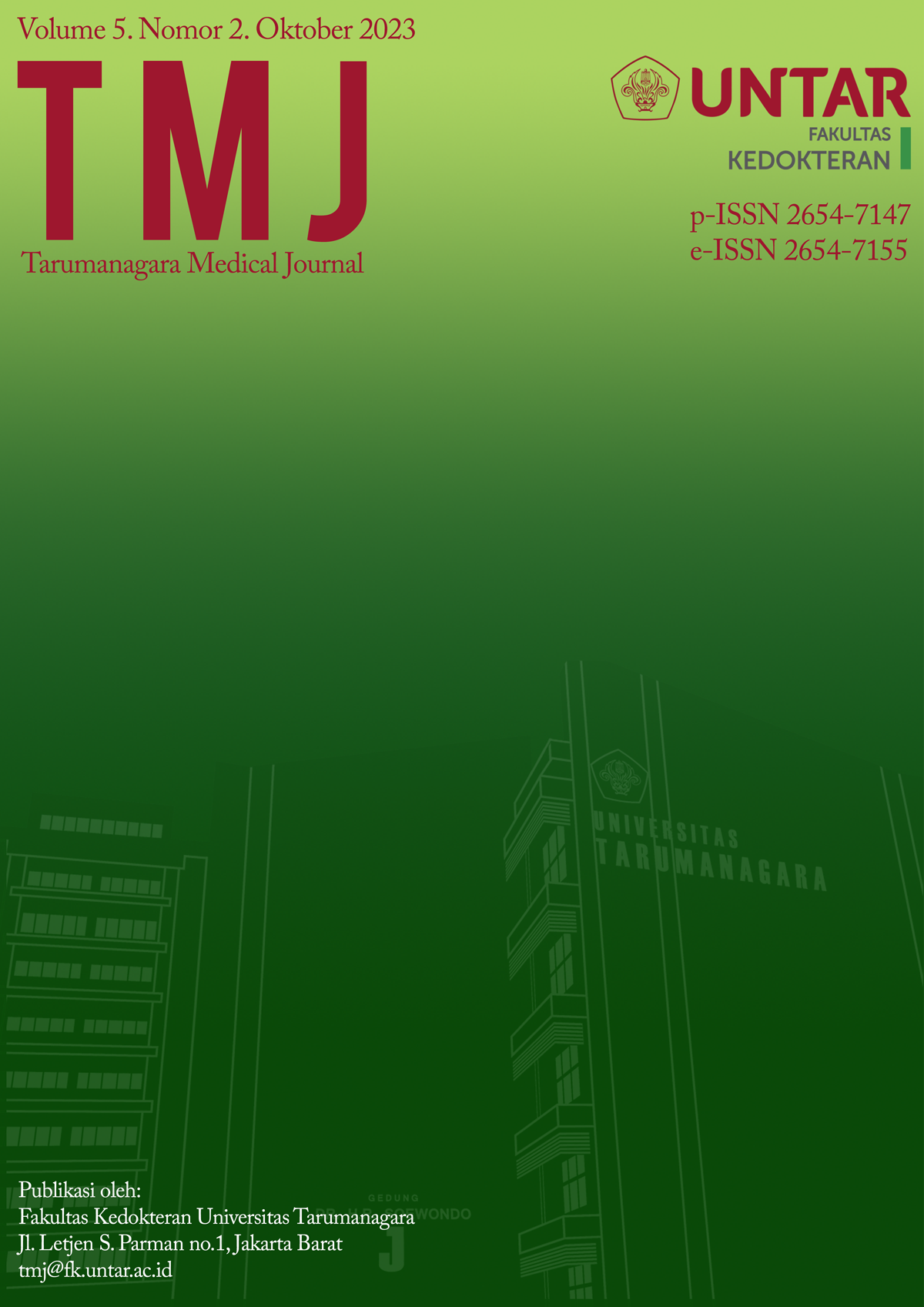Hubungan antara konsumsi protein dengan keparahan dermatitis atopik pada mahasiswa kedokteran Universitas Tarumanagara Angkatan 2020-2021
Main Article Content
Abstract
Dermatitis atopik (DA) memiliki karakteristik yang bisa dilihat secara klinis dengan adanya lesi eksim kronik rekuren, kulit kering, serta pruritus. Perbedaan data terkait konsumsi protein, di mana protein yang tinggi dapat menyebabkan DA namun kekurangan protein juga dapat menyebabkan DA, membuat studi ini perlu dilakukan dengan tujuan untuk mengetahui hubungan konsumsi protein dengan keparahan dermatitis atopik. Studi analitik observasional yang didesain secara cross-sectional dilakukan terhadap mahasiswa kedokteran Universitas Tarumanagara angkatan 2020 dan 2021. Responden dalam studi ini berjumlah 79 mahasiswa yang telah didiagnosis dermatitis atopic menggunakan serangkaian instrument. Pengambilan responden menggunakan teknik consecutive sampling. Konsumsi protein dinilai dengan Recommended Daily Allowance (RDA) protein. Pada studi didapatkan mayoritas mengalami dermatitis atopik ringan (65,8%) dan mengonsumsi protein di bawah batas yang dianjurkan, yaitu 5,6 g/kgBB/minggu (79,7%). Sebanyak 38 (60,3%) orang dari 63 responden yang mengonsumsi protein di bawah batas anjuran mengalami dermatitis atopi ringan. Hal yang sama juga terjadi pada 14 (87,5%) orang dari 16 responden yang mengonsumsi protein ≥ 5,6 gram/kgBB/hari mengalami dermatitis ringan. Secara statistik didapatkan hubungan yang signifikan antara konsumsi protein dengan keparahan dermatitis atopik (p-value = 0,04). Hasil studi memperlihatkan sesorang yang mengonsumsi protein kurang maupun berlebih lebih cenderung mengalami dermatitis atopik derajat ringan.
Article Details

This work is licensed under a Creative Commons Attribution-NonCommercial-ShareAlike 4.0 International License.
Penulis yang menerbitkan artikelnya di Tarumanagara Medical Journal (TMJ) setuju dengan ketentuan sebagai berikut:
- Penulis mempertahankan hak cipta dan memberikan jurnal hak publikasi pertama dengan bekerja secara bersamaan dilisensikan di bawah Creative Commons Attribution yang memungkinkan orang lain untuk berbagi karya dengan pengakuan atas kepengarangan dari karya asli dan publikasi dalam jurnal ini.
- Penulis dapat masuk ke dalam pengaturan kontrak tambahan yang terpisah untuk distribusi non-eksklusif jurnal versi pekerjaan yang dipublikasikan (misalnya, memposting ke repositori institusional atau menerbitkannya dalam buku), dengan pengakuan publikasi awal dalam jurnal ini.
- Setiap teks yang dikirim harus disertai dengan "Perjanjian Transfer Hak Cipta" yang dapat diunduh melalui tautan berikut: Unduh
References
Yao X, Song ZQ, Li W, Liang YS, Zhao Y, Cao H, et al. Guidelines for Diagnosis and Treatment of Atopic Dermatitis in China. Int J Dermatol Venereol. 2021;4(1):1-9.
Abbas AK, Lichtman AH, Pillai S. Basic Immunology: Functions and Disorders of the Immune System 6 th Edition. Philadelphia: Elsevier; 2020.
Eichenfield LF, Tom WL, Chamlin SL, Feldman SR, Hanifin JM, Simpson EL, et al. Guidelines of care for the management of atopic dermatitis: Section 1. Diagnosis and assessment of atopic dermatitis Work Group. J Am Acad Dermatol. 2014;70(2):338–51.
Tait C, Goldman RD. Dietary exclusion for childhood atopic dermatitis. Canadian Family Physician. 2015;61(7):609-11.
Yang AR, Kim YN, Lee BH. Dietary intakes and lifestyle patterns of Korean children and adolescents with atopic dermatitis: Using the fourth and fifth Korean National Health and Nutrition Examination Survey (KNHANES IV,V), 2007–11. Ecol Food Nutr. 2016;55(1):50–64.
Kapur S, Watson W, Carr S. Atopic dermatitis. Vol. 14, Allergy, Asthma and Clinical Immunology. BioMed Central Ltd. 2018.
Berke R, Singh A, Guralnick M. Atopic Dermatitis: An Overview. Am Fam Physician. 2012;86(1):35-42.
Thomsen SF. Atopic Dermatitis: Natural History, Diagnosis, and Treatment. ISRN Allergy. 2014;2014:1–7.
Raymond JL, Morrow K. Krause and Mahan’s Food & The Nutrition Care Process. 15th ed. Saunders.2020
Pesce G, Marcon A, Carosso A, Antonicelli L, Cazzoletti L, Ferrari M, et al. Adult eczema in Italy: Prevalence and associations with environmental factors. J Eur Acad Dermatol Venereol. 2015;29(6):1180–7.
Möhrenschlager M, Seeli C, Anasiewicz N. Atopic dermatitis in a population-based cohort from Stockholm, Sweden 24 years after start: new data, new questions. Vol. 36, Journal of the European Academy of Dermatology and Venereology. John Wiley and Sons Inc; 2022. p. 634.
Chan LN, Magyari A, Ye M, Al-Alusi NA, Langan SM, Margolis D, et al. The epidemiology of atopic dermatitis in older adults: A population-based study in the United Kingdom. PLoS One. 2021;16(10):e0258219.
Kanda N, Hoashi T, Saeki H. The roles of sex hormones in the course of atopic dermatitis. Vol. 20, Int J Mol Sci. 2019;20(19):4660.
Tham EH, Rajakulendran M, Lee BW, Van Bever HPS. Epicutaneous sensitization to food allergens in atopic dermatitis: What do we know? Pediatr Allergy Immunol. 2020;31(1):7–18.
Liu W, Cai J, Sun C, Zou Z, Zhang J, Huang C. Time-trends for eczema prevalences among children and adults from 1985 to 2015 in China: a systematic review. BMC Public Health. 2022;22:1294.
Badan Ketahan Pangan Kementerian Pertanian. Direktori Perkembangan Konsumsi Pangan. Jakarta: Kementerian Pertanian; 2021.
Utami AM, Kurniati AM, Ayu DR, Husin S, Liberty IA. Perilaku makan dan aktivitas fisik mahasiswa Pendidikan dokter di masa Pandemi Covid-19. Jurnal Kedokteran dan Kesehatan Publikasi Ilmiah Fakultas Kedokteran Universitas Sriwijaya. 2021;8(3):179–92.
Holm JG, Agner T, Clausen ML, Thomsen SF. Quality of life and disease severity in patients with atopic dermatitis. J Eur Acad Dermatol Venereol. 2016;30(10):1760–7.
Grafanaki K, Bania A, Kaliatsi EG, Vryzaki E, Vasilopoulos Y, Georgiou S. The Imprint of Exposome on the Development of Atopic Dermatitis across the Lifespan: A Narrative Review. J Clin Med. 2023;12(6):2180.
Flohr C, Mann J. New insights into the epidemiology of childhood atopic dermatitis. Vol. 69, Allergy. 2014;69(1):3–16.
Venkataraman D, Soto-Ramírez N, Kurukulaaratchy RJ, Holloway JW, Karmaus W, Ewart SL, et al. Filaggrin loss-of-function mutations are associated with food allergy in childhood and adolescence. J Allergy Clin Immunol. 2014;134(4):876-82.



